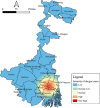Geographic information system-aided evaluation of epidemiological trends of dengue serotypes in West Bengal, India
- PMID: 38577856
- PMCID: PMC11050753
- DOI: 10.4103/ijmr.ijmr_1055_23
Geographic information system-aided evaluation of epidemiological trends of dengue serotypes in West Bengal, India
Abstract
Background objectives: West Bengal is a dengue-endemic State in India, with all four dengue serotypes in co-circulation. The present study was conceived to determine the changing trends of circulating dengue virus (DENV) serotypes in five consecutive years (2015-2019) using a geographic information system (GIS) during the dengue season in West Bengal, India.
Methods: Molecular serotyping of dengue NS1 sero-reactive serum samples from individuals with ≤5 days of fever was performed using conventional nested reverse transcriptase-PCR. GIS techniques such as Getis-Ord Gi* hotspot analysis and heatmap were used to elucidate dengue transmission based on the received NS1-positive cases and vector data analysis was used to point out risk-prone areas.
Results: A total of 3915 dengue NS1 sero-positive samples were processed from most parts of West Bengal and among these, 3249 showed RNA positivity. The major circulating serotypes were DENV 3 (63.54%) in 2015, DENV 1 (52.79%) in 2016 and DENV 2 (73.47, 76.04 and 47.15%) in 2017, 2018 and 2019, respectively. Based on the NS1 positivity, dengue infections were higher in males than females and young adults of 21-30 yr were mostly infected. Getis-Ord Gi* hotspot cluster analysis and heatmap indicate that Kolkata has become a hotspot for dengue outbreaks and serotype plotting on maps confirms a changing trend of predominant serotypes during 2015-2019 in West Bengal.
Interpretation conclusions: Co-circulation of all the four dengue serotypes was observed in this study, but only one serotype became prevalent during an outbreak. Representation of NS1-positive cases and serotype distribution in GIS mapping clearly showed serotypic shift in co-circulation. The findings of this study suggest the need for stringent surveillance in dengue-endemic areas to limit the impact of dengue and implement better vector-control strategies.
Copyright © 2024 Copyright: © 2024 Indian Journal of Medical Research.
Conflict of interest statement
None.
Figures






Similar articles
-
Haematological parameters as predictors of severe dengue: A study from northern districts of West Bengal, India.J Vector Borne Dis. 2025 Apr 1;62(2):218-225. doi: 10.4103/JVBD.JVBD_119_24. Epub 2024 Dec 5. J Vector Borne Dis. 2025. PMID: 39636263
-
Development of an affordable multiplex quantitative RT-PCR assay for early detection and surveillance of Dengue, Chikungunya, and co-infections from clinical samples in resource-limited settings.PLoS Negl Trop Dis. 2025 Aug 11;19(8):e0013250. doi: 10.1371/journal.pntd.0013250. eCollection 2025 Aug. PLoS Negl Trop Dis. 2025. PMID: 40788955 Free PMC article.
-
Prevalence of Different Dengue Serotypes in Northern India, 2021-2022: A Tertiary Care Hospital-Based Study.Am J Trop Med Hyg. 2024 Dec 10;112(3):636-641. doi: 10.4269/ajtmh.24-0416. Print 2025 Mar 5. Am J Trop Med Hyg. 2024. PMID: 39657227
-
Serotypic and genotypic profile of dengue virus outbreaks in India between 2011 and 2017.J Vector Borne Dis. 2025 Apr 1;62(2):135-142. doi: 10.4103/JVBD.JVBD_101_24. Epub 2024 Oct 5. J Vector Borne Dis. 2025. PMID: 39374060 Review.
-
Meta-Analysis of Dengue Severity during Infection by Different Dengue Virus Serotypes in Primary and Secondary Infections.PLoS One. 2016 May 23;11(5):e0154760. doi: 10.1371/journal.pone.0154760. eCollection 2016. PLoS One. 2016. PMID: 27213782 Free PMC article.
Cited by
-
Incidence and Outcome of Dengue Fever During Pre-monsoon, Monsoon, and Post-monsoon Periods: A Cross-Sectional Study From a Tertiary Care Hospital in India.Cureus. 2025 Apr 21;17(4):e82669. doi: 10.7759/cureus.82669. eCollection 2025 Apr. Cureus. 2025. PMID: 40400793 Free PMC article.
-
Evolving epidemiology, clinical features, and genotyping of dengue outbreaks in Bangladesh, 2000-2024: a systematic review.Front Microbiol. 2024 Oct 30;15:1481418. doi: 10.3389/fmicb.2024.1481418. eCollection 2024. Front Microbiol. 2024. PMID: 39539699 Free PMC article.
-
Spatio-temporal distribution of dengue cases and vectors along with the interrelationship of environmental and climatic factors in the metropolitan city, Kolkata, India, for 2017-2022: calling implications for vector control.Emerg Microbes Infect. 2025 Dec;14(1):2493924. doi: 10.1080/22221751.2025.2493924. Epub 2025 Apr 29. Emerg Microbes Infect. 2025. PMID: 40231455 Free PMC article.
-
Geographic information system & epidemiological trends of dengue serotypes.Indian J Med Res. 2024 Jul;160(1):40. doi: 10.25259/IJMR_332_2024. Indian J Med Res. 2024. PMID: 39382507 Free PMC article. No abstract available.
-
Authors' response.Indian J Med Res. 2024 Jul;160(1):41-42. doi: 10.25259/ijmr.ijmr_1055_23. Indian J Med Res. 2024. PMID: 39382509 Free PMC article. No abstract available.
References
-
- World Health Organization. Dengue and Severe Dengue. [accessed on May 24, 2023]. Available from: https://www.who.int/news-room/fact-sheets/detail/dengue-and-severe-dengue .
-
- Guzman MG, Harris E. Dengue. Lancet. 2015;385:453–65. - PubMed
-
- Agarwal R, Kapoor S, Nagar R, Misra A, Tandon R, Mathur A, et al. A clinical study of the patients with dengue hemorrhagic fever during the epidemic of 1996 at Lucknow, India. Southeast Asian J Trop Med Public Health. 1999;30:735–40. - PubMed
Publication types
MeSH terms
Substances
LinkOut - more resources
Full Text Sources
Medical

